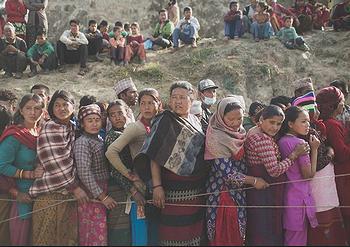
NEW YORK, New York, February 11, 2016 (ENS) – At least 98.6 million people were harmed by natural disasters in 2015, the hottest year on record; and climate, intensified by a strong El Niño pattern, was the driver in 92 percent of those events, finds a new analysis by the UN Office for Disaster Risk Reduction, UNISDR.

The disasters having the greatest impact were the 32 major droughts recorded during 2015, which amounted to more than double the 10-year annual average and affected 50.5 million people.
“The main message from this trends analysis is that reducing greenhouse gases and adapting to climate change is vital for countries seeking to reduce disaster risk now and in the future,” said Robert Glasser, the secretary-general’s special representative for disaster risk reduction and head of UNISDR.
The five countries hit by the highest number of disasters in 2015 are: China, with 26 disasters; the United states, with 22; India, with 19; Philippines, with 15; and Indonesia, with 11.
Floods had the second-greatest impact in 2015, after droughts, with 152 floods affecting 27.5 million people and claiming 3,310 lives.
This compares with the 10-year average of 5,938 deaths from floods and 85.1 million people affected.

Storms resulted in 996 deaths and affected 10.6 million people around the world in 2015, compared with a 10-year average of 17,778 deaths and 34.9 million people affected, the analysis shows.
Asia and the Pacific bore the brunt of the 90 storms reported this past year, which included 48 cyclone-strength storms, attributable to rising sea levels and sea surface temperatures.
But fewer people in Asia died in storms last year that over the 10-year average. “National disaster management agencies in Asia are doing good work in reducing death tolls from storms through early warnings and timely evacuations, especially in the Philippines, China, Japan and the small island states of the Pacific,” Glasser said.
The Belgian-based Centre for Research on the Epidemiology of Disasters, CRED, which helped to compile the analysis, calculates the death toll from 346 major reported disasters this past year was 22,773, including 8,831 deaths from the Nepal earthquake alone.

Noting that the overall disaster mortality for 2015 was down on the 10-year average of 76,424 deaths, CRED Director Debarati Guha-Sapir emphasized that early warnings are having an impact in the case of storms.
“Further investment in this area is warranted by these numbers,” she said.
Guha-Sapir observed that extreme temperatures, mostly heatwaves, were severe in 2015, leading to the hottest year on record and contributing to a combined total of 7,346 deaths that affected 1.2 million people, particularly in France, India and Pakistan.
This compares with the 10-year average of 7,232 deaths and 8.7 million affected.
“Mortality from extreme temperatures are very under-estimated and need better evaluation of their impact,” she explained.
The analysis also shows that earthquakes and tsunamis killed 9,525 people and affected 7.2 million.
In addition, landslides, triggered by heavy rains, killed 1,369 people and affected 50,332; while wildfires took 66 lives and affected almost 495,000 people.
The UN is engaging its agencies and hundreds of scientists, policy makers and members of the private sector and civil society in reducing disaster risk by working to implement the new Sendai Framework for Disaster Risk Reduction 2015-2030.
This plan was adopted at the Third UN World Conference on Disaster Risk Reduction in Sendai, Japan, on March 18, 2015. Over the next 15 years, it aims to prevent new and reduce existing disaster risks by strengthening and promoting collaboration and capacity-building.
The Sendai Framework outlines four priorities for action:
* – Understanding disaster risk
* – Strengthening disaster risk governance to manage the risk
* – Investing in disaster reduction for resilience
* – Enhancing disaster preparedness for effective response, and to build back better in recovery, rehabilitation and reconstruction.
In late January, hundreds of participants from all over the world met in Geneva to launch the UNISDR Science and Technology Partnership and the Science and Technology Road Map for the implementation of the Sendai Framework.
Copyright Environment News Service (ENS) 2016. All rights reserved.
© 2016, Environment News Service. All rights reserved. Content may be quoted only with proper attribution and a direct link to the original article. Full reproduction is prohibited.
